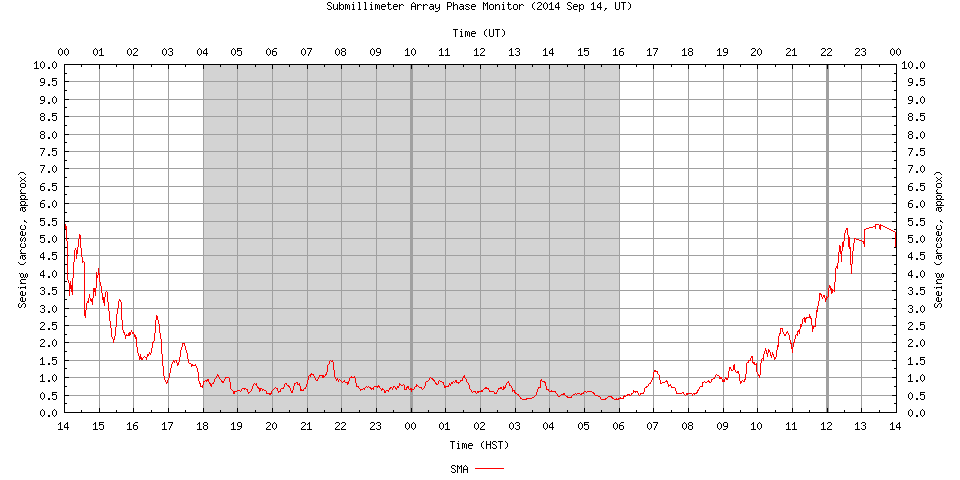Seeing data from the SMA is monitored during observing. The data can be accessed by summit observers on the tonight page.
You can find the seeing information for your data in the fitsheader parameters SEEINGST and SEEINGEN. These give the SAO atmospheric seeing in arcsecs at the start and end of the observation respectively.
Observing guidelines state:
- Only observe at 850 microns if the seeing is below 2″
- Only observe at 450 microns if the seeing is below 1″
Discussion of the effect of seeing on SCUBA-2 data
The SMA (or SAO) seeing monitor receives a signal from a satellite beacon at 12.43 GHz. What is measured is the phase rms of two signals from the satellite received 33 meters apart. The phase rms at another frequency is calculated by scaling with the frequency e.g. a 1 deg phase rms at 12.43 GHz corresponds to 54 degrees phase rms at 450 micron.
The seeing value reported at the JCMT is just the measured phase rms at 12.43 GHz (Note the SMA weather page have scaled the phase rms to 225 GHz i.e. multiplied with 225/12.43). Thus a seeing report as 1″ implies a phase rms of 54 degrees at 450 micron. That is rather gross estimate corresponding to a surface rms of 63 micron.
However, this phase rms is mainly tip/tilt. The beam moves roughly around +/- the given seeing i.e. in this case +/- 1″. Even if the tip/tilt is responsible for 60-70% of the above surface rms, the remaining rms is still a worry. However, the remaining rms is mainly in large scale surface ‘deformation’ as spherical aberration and coma. This increases the side lobes and the effective beam size but the flux integrated over a small aperture will still be quite stable – it might only drop of order 10%. You will have to have a big enough aperture to include the beam motion. So we will still expect good arcsec FCFs at 450 micron up to 1″ seeing.
As described above the main effect is tip/tilt of the beam. The typical time scale for the tip/tilt motion of the beam is on the order of a few seconds. This will disturb observations like HARP pointing when we take 5-7 data points each 5-10 seconds in length. In 2″ seeing the beam can move +/-2″ from the grid points that are spaced ~7″ apart making for pointing results that jumps around. Similarly HARP and SCUBA-2 focuses are affected. Pointing with SCUBA-2 should be better off since we then obtain an average image over the full exposure time.




